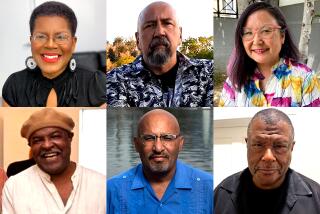The Brown Buffalo: No Mere Gonzo Writer : NONFICTION : OSCAR “ZETA” ACOSTA: The Uncollected Works,<i> Edited by Ilan Stavans (Arte Publico Press: $14.95, 368 pp.)</i>
Who wants to jump into a debate over what a role model ought to be--as opposed to who he was? Initially, I was wary of reviewing this anthology of published and unpublished fiction and nonfiction writings of the late Oscar “Zeta” Acosta, the legendary Chicano lawyer and novelist.
As Ilan Stavans, the editor, so aptly put it: “[Acosta’s] anarchism has been glorified and ridiculed and his misogynist views have been consistently attacked by feminists.” And with good reason.
Romantics have nurtured his legend, that of the so-called Brown Buffalo. There is much to ponder: Beyond his reputation as a womanizer and carouser, Acosta was one of the first militant Chicano lawyers to represent poor Mexicans and Mexican Americans in East Los Angeles. He took on some of the biggest political issues of the late 1960s and early ‘70s.
In one case, he challenged the county’s grand jury system. Flamboyantly deposing Superior Court judges, he found that 178 of them had nominated 1,501 people to the grand jury, of which only 20 had Spanish surnames. Nearly 92% of the judges had never nominated a Spanish-surnamed person. Acosta’s angry brief is just as pertinent today as it was in 1969.
Beyond his legal work, Acosta gained notoriety with two fictional works that captured the rise of the Chicano movement in Los Angeles during the late 1960s, “The Autobiography of a Brown Buffalo” and “The Revolt of the Cockroach People.” In a pop cultural context, he was the real-life model for Hunter S. Thompson’s attorney and garrulous traveling companion in “Fear and Loathing in Las Vegas.” But he was no mere gonzo writer, like Thompson.
More than most Chicano authors, Acosta captured the image of “vato loco,” the crazy street dude. To sympathetic whites, he was a free spirit. To other observers, he was merely the racist “noble savage” stereotype found in books like John Steinbeck’s “Tortilla Flat.”
In truth, Acosta symbolized the anarchist streak in the Mexican--someone who disagrees for the sake of disagreeing. He was the hero who takes on the American Goliath and, because of skill and circumstance, achieves what the average working-class family man cannot. He was also a sexist, a man who was never able to respect or accept women, especially of his heritage.
For most of his life, Acosta was at war with himself, and it began with his name. In “From Whence I Came,” an autobiographical essay, he wrote: “ . . . [W]ith a name like Acosta, one would be given an honest name like Pedro,” but have you “ever heard anyone of any worth named Pete? And can you imagine a broad saying, ‘Oh, Pete, darling. . . .’ Christ, the more I think of it, maybe ‘Oscar’ is a pretty name.’ ”
Non-Latinos may think this nonsensical, but it represents a significant process by which Acosta and other Mexican Americans come to grips with their identity. Indeed, this book tells us about the American dream and the price you pay for getting a piece of it. While others in the Mexican American community surrendered to the dream, Acosta skirted its edges. His lack of mainstream acceptance and his demons kept him from falling in. Yet one should not blame drugs, the 1960s or machismo for his failures. Like the Doors’ Jim Morrison, whom Acosta, a fellow musician, admired, Acosta was out of control. And this should not be romanticized.
Raised in Modesto, he grew up in a nuclear family, played sports, excelled in music and was the president of his class--no small feat in a town where “Mexican” was a dirty word. Acosta passed up a music scholarship at USC to join the Air Force, where he played in the band. He started playing jazz at that time, as well as smoking marijuana and taking “bennies.”
Given to extremes, he abandoned Catholicism and briefly became a Baptist minister before abandoning religious faith altogether. After his military service, he returned home and married Betty Daves, a Midwesterner with Southern roots. Soon afterward, Acosta attempted suicide and in 1957 began psychiatric treatment. During this period, he divorced Daves.
One can only speculate on the reasons for Acosta’s breakdown, because neither his writings nor this book addresses this issue. After his discharge from psychiatric care, he attended San Francisco State, where he majored in creative writing and mathematics. He later went to law school while working part-time.
After working as a legal aid attorney through 1967, Acosta quit the law and began wandering through the Southwest. He came back to Los Angeles just in time for the East Los Angeles “blowouts” of 1968--a series of mass demonstrations where more than 10,000 Chicano students walked out of East Los Angeles high schools, protesting educational inequality and discrimination. It was at this time that Acosta dubbed himself “Buffalo Z. Brown,” and began providing legal representation to poor Mexicans and Mexican Americans in East Los Angeles.
The origins of the “Z” or “Zeta” in his name are not fully explained. But if the times offer a clue, the “X” in Malcom X’s name played a part, or perhaps the movie “Z,” then popular, could have been a factor. Either way, the Chicano community asked no questions. There were simply no Chicano lawyers like Acosta around, and Chicanos were not then considered part of the civil rights equation. Acosta played a key role in issues ranging from the National Chicano Moratorium and the defense of Blowout leaders to protests against the Catholic Church.
Acosta married his second wife, Socorro Anguiniaga, in 1969, and even though he divorced her, he had finally began dating women of his own ethnicity. Still, his personal life accentuated the flaws in any culture in which, for some men, women have no faces; it also underscored his self-destructive tendencies. Despite his activism, drugs were his first love.
“I think psychedelic drugs have been important to the development of my consciousness,” Acosta wrote in one essay. Under murky circumstances, he is believed to have died in 1974 at the age of 39 in Mazatlan, Mexico, from unknown causes. His body was never found.
“Oscar ‘Zeta’ Acosta: The Uncollected Works” is worth reading, despite a lack of complete annotation and an introduction that does not fully illuminate his times. Three sections are of particular interest: “Challenging Racial Exclusion on the Grand Jury: The East L.A. 13 vs. the L.A. Superior Court,” “Una Carta de Zeta al Barrio” (“A Letter to the Barrio”) and Acosta’s anarchist platform during his June, 1970, run for Los Angeles County sheriff. In that race, in which he received 108,755 votes, Acosta promised to abolish the office.
The next year, Acosta quit law again, met Thompson, the gonzo guru, and traveled with him to Las Vegas. In 1972, he published “The Autobiography of a Brown Buffalo” and then “The Revolt of the Cockroach People.” These two books, portions of which are abstracted in this collection, can be read as evocative period pieces of a pivotal moment in Chicano culture.
But it is hard to romanticize the man, especially when his record as an activist takes up barely three years. It is hard, in short, not to speculate what might have been if the comet had not wasted itself.
More to Read
Sign up for our Book Club newsletter
Get the latest news, events and more from the Los Angeles Times Book Club, and help us get L.A. reading and talking.
You may occasionally receive promotional content from the Los Angeles Times.






